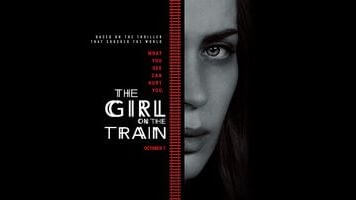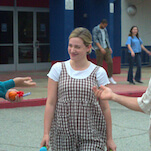“I read once that when a train hits, it can rip the clothes right off of you,” says Megan Hipwell (Haley Bennett), a beautiful blond in snakeskin boots, idly half-straddling a sofa while her very handsome therapist, Dr. Kamal Abdic (Édgar Ramírez), strokes his bearded chin like a pervert trying to play it cool. This is how it is in The Girl On The Train: attractive, bored, and oh-so-disaffected residents of New York’s cushy Westchester County, acting in ways that don’t resemble actual human behavior to create a matrix of deception, infidelity, voyeurism, and murder. A couple of decades ago, this hodgepodge of suspicion and literally steamy sex might have been an Adrian Lyne movie (Lyne’s fine Claude Chabrol remake Unfaithful seems to have had some influence on the setting); in today’s Hollywood, it’s an attempt to replicate the corrosive arch knowingness of David Fincher’s Gone Girl adaptation, tasked to Tate Taylor, director of The Help.
The premise is visual, quasi-Hitchcockian, and not half bad. An MTA Metro-North train whisks Manhattan commuters past the ample backyards of the bedroom suburb of Ardsley-On-Hudson; alcoholic English expat Rachel (Emily Blunt, doing yeoman’s work) rides it twice a day, engrossed in the private movie screen of her train window. The audience will soon learn that she used to live here, in the nice house at 13 Beckett Road. It’s now the home of her ex-husband, Tom Watson (Justin Theroux), and his bleached-blond second wife, Anna (Rebecca Ferguson), who used to be their realtor. For whatever reason, Rachel has become obsessed with the house next door to theirs, where Megan lives with her hunky husband Scott (Luke Evans). This makes her an important but completely unreliable witness once the young Mrs. Hipwell disappears, leaving behind a trail of secrets, as alienated women are wont to do in thrillers that have Girl in the title.
One can’t help but imagine what a different filmmaker might have made of this lurid, plot-hole-riddled soap opera with a body count (including a perfect over-the-top image of bourgeois degeneracy: murder by wine corkscrew) or the character of Rachel, a bad drunk whose list of past humiliations includes an incident in which she stumbled into the Watsons’ house in an apparent attempt to kidnap their infant daughter. It’s appetizing and potentially subversive: an unraveling missing person case in which the only motivators are the suburban standbys of childbearing, real estate, and the wandering eye, and the heroine is a baby-snatching stalker ex who sucks vodka out of a water bottle. With enough oomph, it might not even matter that it’s never clear where any of the characters get money or whether they have any family aside from their spouses.
But Taylor’s direction is cosmetic, focused on well-groomed and well-dressed actors, spotless interiors, and the arty, textured camerawork supplied by cinematographer Charlotte Bruus Christensen, whose gifts are both self-evident and sort of wasted here. It’s artificial without a hint of intentional façade: No home looks lived in and no conversation feels like it could have occurred outside of a laboratory environment. The Girl On The Train is based on the bestselling novel by Paula Hawkins, which was set in the far less affluent suburbs of London, where the characters’ WASPish names (unchanged from the book) would just seem unremarkably English; one can’t help but wonder, though, about the presumably colorful explanation for how Ramírez’s character came by his Bosniak name. The screenplay by Erin Cressida Wilson (Secretary, Chloe) keeps the source material’s three narrators (Rachel, Anna, and Megan), but Taylor’s indifference to perspective—exacerbated by a confused and tiresome flashback structure—ensures that they are all equally useless. He can’t frame something as elementary as the point of view of a passenger on a moving train, and only ever stumbles into camp unintentionally.









































